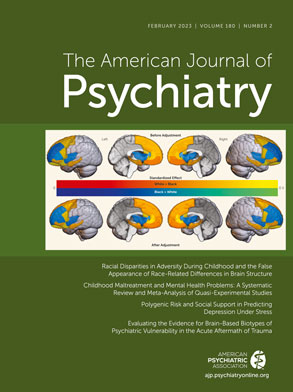The AJP Residents’ Journal is a quarterly e-publication that serves as a forum for resident physicians and fellows to share ideas and experiences in training, clinical practice, research, and careers.
Early Osteopathic Thought on Serious Mental Illness and How Osteopathic Medicine Fits Into Psychiatry Today
Lauren Bonilla, B.A., Jeremy Weleff, D.O.
Osteopathic medical students spend considerable time learning the history, philosophy, and theories of osteopathic manipulative medicine (OMM) and skills of osteopathic manipulative treatment (OMT), all of which are tested on licensing exams. Data from the National Resident Matching Program show that 17.4% of fourth-year osteopathic medical students matched into psychiatry postgraduate year-1 positions in 2021, compared with 6.5% in 2019. Since its inception, osteopathic medicine has theorized about and proposed treatments for serious mental illness, such as mood disorders and schizophrenia. However, there has been minimal mention in osteopathic textbooks of the treatment of these conditions with OMT, limited studies investigating use of OMT for serious mental illness, and no official OMT clinical guidelines for psychiatric conditions. The goal of this article is to contextualize early osteopathic thought about the treatment of serious mental illness, propose reasons for the decline in OMT utilization in psychiatry, and briefly discuss current literature on using OMT in psychiatry.
Anti-NMDA Receptor Encephalitis in a 12-Year-Old Girl
Andrea Boyer, M.D., Sean Christensen, M.D.
Anti-NMDA receptor encephalitis has been an increasingly recognized cause of psychiatric symptoms since it was first identified in 2007. It is an autoimmune disease in which the body creates antibodies against NMDA receptors in the central nervous system, resulting in psychosis, impaired cognition, impaired memory, disordered speech, loss of consciousness, disordered movements, seizures, and autonomic dysfunction. First-line treatment of the underlying pathology is immunotherapy, including intravenous (IV) steroids, IV immunoglobulin (IVIg), or plasmapheresis. If a tumor is involved, it is surgically removed, and the patient is treated with chemotherapy or radiation or both, if the tumor is cancerous. Despite this progress, there is a dearth of knowledge, especially in pediatric patients, of the optimal management of behavioral sequelae and psychotic symptoms, even though they are the most common symptoms in the first month of disease. Here we report a case of anti-NMDA-R encephalitis in a 12-year-old female, who experienced cognitive and behavioral issues that persisted following immunotherapy and surgery.
Peduncular Hallucinosis in the Context of Juvenile Pilocytic Astrocytoma
Anne Cochrane, M.D., M.S., Anthony DeMarco, M.D.
Neurologist Jacques Lhermitte first described peduncular hallucinosis (PH) in 1922 as a rare, heterogeneous syndrome characterized by visual hallucinations secondary to lesions of the brainstem and thalamus. Prevalence of the condition is unknown; a meta-analysis conducted by Galetta and Prasad identified 85 proposed cases of PH in the available literature. The etiology of these lesions includes stroke, neoplasm, and infection. The unique presentation of hallucinations associated with PH is thought to be associated with damage to the reticular and visual systems of the brainstem. Visual hallucinations associated with PH may involve auditory or tactile sensations and be accompanied by behavioral abnormalities. PH generally resolves without treatment, but antipsychotic agents, such as olanzapine and quetiapine, have demonstrated efficacy in management of persistent hallucinations. Our case adds insight to the unclear pathophysiology of the phenomenon and contributes to the limited literature on PH in younger patient populations.
ALSO IN THIS ISSUE
Deafness-Infertility Syndrome and Auditory Hallucinations
Tara S. Lowe, M.D., Philip J. McFarland, M.D.
Diabulimia in a 23-Year-Old Woman With Multiple Comorbid Conditions
Stephen Poos, B.A., Kaitlin McGowan, B.A.
Improvement in Neuropsychiatric Symptoms With the Addition of Nortriptyline in the Context of Mast Cell Activation Syndrome
Rachel Voss, M.D., Maxine Zhou, M.D.
A Brief Review of Quetiapine
Dennis E. Curry, M.D., M.Sc., Brooke L. Richards, B.Sc., Pharm.
Call for Applications to Join the 2023–2024 Editorial Board

